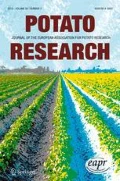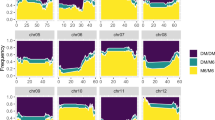Summary
Selfing 24-chromosome hybrids derived by crossing groups Phureja and Stenotomum with the group Tuberosum haploid US-W 4 has produced progenies segregating for many traits. Monogenic segregation ratios of previously described marker genes were confirmed and the inheritance of two new trats was determined. The previously reported linkage between factors for tuber shape and tuber pigmentation was confirmed. The genotypes for several marker genes have been established on the basis of progeny tests for 31 self-compatible diploid clones. These cultivated diploid stocks with known genotypes for marker genes have great potential value for future genetic investigations in potatoes.
Zusammenfassung
Der Mangel an geeigneten, gut definierten Markierungsgenen hat genetische Untersuchungen an Kartoffeln gehemmt. Eine Fülle potentiell möglicher genetischer Variation ist in den selbstunverträglichen kultivierten diploiden Formen vonSolanum tuberosum L., Gruppe Phureja und Gruppe Stenotomum, vorhanden. Diese Variation kann in den selbst-verträglichen, 24-chromosomigen Hybriden, die aus der Kreuzung dieser kultivierten Diploiden mit der Gruppe Tuberosum haploid US-W 4 stammen, ausgenützt werden. Nachkommenschaften geselbsteter 24-chromosomiger Hybrid-Klone wurden auf Aufspaltung der früher beschriebenen MarkierungsgeneP, R, Ac, B, I undF und potentiell wertvoller, neuer Markierungsgene untersucht. Die Bonitierung wurde sowohl visuell als auch durch Dünnschicht-Chromatographie der Blüten- und Knollenschalenpigmente vorgenommen.
Es wurde ein neues Merkmal gefunden, das die Verteilung von Pigmenten auf der Fruchtknotenwand kontrolliert. Diese Eigenschaft scheint monogenetisch dominant vererbt zu werden, und es wurde ihr das Gen-SymbolOw gegeben. Im Pflanzenmaterial, das für diese Arbeit verwendet wurde, warOw mitI in der Kopplungsphase verbunden und mitF in der Repulsionsphase (Tabellen 1 und 2). Ein die Knollenform kontrollierendes Hauptgen scheint ebenfalls mit dieser Gruppe verbunden zu sein (Tabelle 3).
Ein chemogenetischer Markierer wurde in Chromatogrammen entdeckt. Unter ultraviolettem Licht erscheint er als ein glänzendes, fluoreszierendes, blaues Band, im Aussehen sehr ähnlich der Chlorogensäure, aber mit einem niedrigeren Rf-Wert bei gleichem Laufmittel. Dieses Band scheint durch ein einzelnes dominantes Gen vererbt zu sein (Tabelle 4).
Auf Grund der aus der visuellen Beurteilung und der Laboruntersuchung der Nachkommenschaften erhaltenen Information wurden die Genotypen von 31 selbstverträglichen Klonen für einige einfach vererbte Merkmale bestimmt. Zum Beispiel konnte nach der Analyse der durch Selbstung des Klons US-W 8775-34 erhaltenen Nachkommenschaft der Genotyppp. RR. FF. ii. owow. Acac bestimmt werden. Klone, wie dieser, mit bekannten Genotypen für einzelne Markierungsgene haben grossen potentiellen Wert für zukünftige genetische Untersuchungen an Kartoffeln.
Résumé
La rareté de marqueurs génétiques appropriés, bien définis, a handicapé les études génétiques chez la pomme de terre. Il existe une abondante variation génétique, potentiellement utilisable dans les diploïdes cultivés auto-incompatibles,Solanum tuberosum L. groupe Phureja et groupe Stenotomum. Cette variation peut être exploitée dans les hybrides auto-compatibles à 24 chromosomes dérivés de croisements de ces diploïdes cultivés avec le haploïde US-W4 du groupe Tuberosum. On a retenu les descendances issues de l'autofécondation de clones hybrides à 24 chromosomes pour la ségrégation de gènes marqueurs précédemment décrits,P, R, Ac, B, I etF et de nouveaux gènes potentiellement utilisables. Le classement a été fait à la fois d'après examen visuel et d'après l'analyse chromatographique en couche mince de pigments de fleur et de la peau du tubercule.
On a découvert un caractère nouveau qui règle l'apparition des pigments sur la paroi ovarienne. Ce caractère paraît être hérité comme un simple gène dominant, et on lui a attribué le symboleOw. Dans le matériel ‘plante’ utilisé dans la présente étudeOw est lié àI dans la phase d'accouplement et avecF dans la phase de séparation (Tableaux 1 et 2). Un gène majeur qui règle la forme du tubercule paraît également associé avec de groupe de liaison (linkage) (Tableau 3).
On détecte un marqueur chimiogénétique dans les chromatogrammes. Sous lumière ultraviolette, il apparaît comme une bande d'un bleu brillant fluorescent très sensible en apparence à l'acide chlorogénique, mais avec une valeur inférieure Rf dans le même solvant de développement. L'hérédité de cette bande est semblable à celle d'un simple gène dominant (tableau 4).
On a déterminé les génotypes de 31 clones auto-compatibles pour plusieurs caractères à hérédité simple, en se basant sur le comptage visuel et l'examen au laboratoire des descandances. Par exemple, d'après l'analyse de la descendance d'autofécondation du clone US-W 8775-43, on peut attribuer à celui-ci le génotypepp. RR. FF. ii. owow. Acac. Des clones tels que celui-ci, de génotypes connus pour plusieurs gènes marqueurs, possèdent une grande valeur potentielle pour les futures études génétiques chez la pomme de terre.
Similar content being viewed by others
References
De Jong, H., 1971. Inbreeding in cultivated diploid potatoes, Ph.D. Thesis, University of Wisconsin, pp. 114.
De Jong, H. & Rowe, P. R., 1971. Inbreeding in cultivated diploid potatoes.Potato Res. 14: 74–83.
Dodds, K. S. & Long, D. H., 1955. The inheritance of colour in diploid potatoes 1. Types of anthocyanidins and their genetic loci.J. Genet. 53: 136–149.
Dodds, K. S. & Long, D. H., 1956. The inheritance of colour in diploid potatoes 2. A three factor linkage group.J. Genet. 54: 27–41.
Harborne, J. B., 1958. The chromatographic identification of anthocyanin pigments.J. Chromatogr. 1: 473–488.
Harborne, J. B., 1959. The chromatography of the flavonoid pigments.J. Chromatogr. 2: 581–604.
Harborne, J. B., 1960. Plant polyphenols. 1. Anthocyanin production in the cultivated potato.Biochem. J. 74: 262–269.
Hougas, R. W. & Peloquin, S. J., 1962. Exploitation ofSolanum germ plasm. In: D. S. Correll, The potato and its wild relatives p. 21–24. Texas Research Foundation, Renner, Texas.
Howard, H. W., 1970. Genetics of the potato,Solanum tuberosum. Logos Press, London, pp. 126.
Howard, H. W., Kukimura, H. & Whitmore, E. T., 1970. The anthocyanin pigments of the tubers and sprouts ofTuberosum potatoes.Potato Res. 13: 142–145.
Peloquin, S. J. & Hougas, R. W., 1959. Decapitation and genetic markers as related to haploidy inSolanum tuberosum.Eur. Potato J. 2: 176–183.
Pushkarnath, 1960. Potato flower biology series. I. Flower and flowering.Indian Potato J. 2: 12–29
Simmonds, N. W., 1965. Mutant expression in diploid potatoes.Heredity 20: 65–72.
Tamura, Z., 1965. Brush type sample applicator for thin-layer chromatography.J. Chromatogr. 19: 429–431.
Author information
Authors and Affiliations
Additional information
Cooperative investigations of the Plant Science Research Division, Agricultural Research Service, U.S. Department of Agriculture, and the Wisconsin Agricultural Experiment Station.
Rights and permissions
About this article
Cite this article
de Jong, H., Rowe, P.R. Genetic markers in inbred clones of cultivated diploid potatoes. Potato Res. 15, 200–208 (1972). https://doi.org/10.1007/BF02361807
Accepted:
Published:
Issue Date:
DOI: https://doi.org/10.1007/BF02361807




